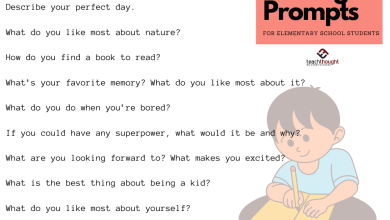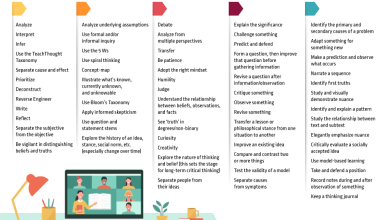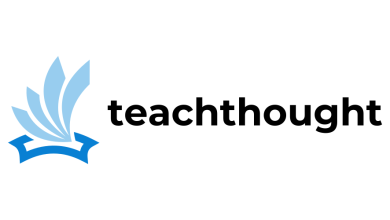How To Transcribe Interviews (With Examples) –
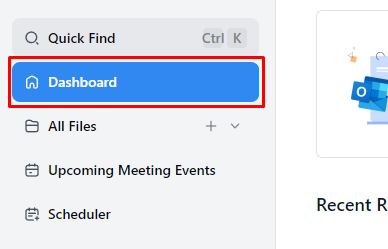
by TeachThought Staff

It’s difficult to remember every key detail during an interview without writing it down—mainly if you’re conducting many interviews quickly. Which candidate had that impressive portfolio? What did that customer say about our product launch?
That’s why if you’re not already transcribing interviews, you should be. It serves as a written record to go back and reference for qualitative research, job interviews, and quoting subjects for publication. If you’re not sure where to start, keep reading. Using my experience conducting customer research and trying out different kinds of transcription, below is a guide on how to transcribe interviews. Plus, there are some examples of what they look like so you can start your own.
What is an Interview Transcription?
An interview transcription is when you write the spoken words of the interviewer and interviewee. Interviews can occur over the phone, on video, or in person. Usually, it’s recorded and either a transcriptionist or a piece of transcription software turns this into written text.
Transcripts are divided by ‘speaker tags’, so you know who says what. It documents precisely what each person says during the interview with timestamps.
Why Will You Need an Interview Transcription?
Using Interviews in Research
Creating a transcription in qualitative research helps you code specific phrases or keywords and use them as part of your qualitative feedback. You don’t have to listen to every interview all the way through, saving you work hours. Use software or a spreadsheet to collate the information in your findings.
Quoting Subjects
When transcribing interview audio, you don’t have to struggle to scribble down what they say and potentially miss something. It frees up your time to listen to and engage with them—you can go back later on and read the transcript for reference and exact quotes.
Transcribe Exactly What’s Said
Having a written record of the conversation helps you review information you might otherwise forget or revisit parts that seemed unclear at the time.
How to Transcribe an Interview
Step 1: Listen to the Interview Recording
Use your favorite media player to play the interview recording. Familiarize yourself with the conversation, especially if you weren’t present, as it’ll give you an idea of who’s speaking and the context of the conversation.
Step 2: Choose a Transcription Type
There are different ways to convert your interview audio into text:
- Transcription services: Human transcriptionists will listen to your audio, and then write it as text. These services are the most accurate but can be costly and slow.
- Transcription software: Tools like Notta use language and speech recognition technology to turn audio into the written word accurately. This is much quicker than a transcription service because there’s no human involved. It can be less accurate, mainly if there’s background noise in the audio file.
- Manual transcription: A do-it-yourself option where you type out the timestamps, speakers, and speech as text as you listen to the audio. You can use free text editors and media players, but it’s time-consuming.
For speed and accuracy, we recommend transcription software like Notta.
Step 3: Get Transcription Software
With Notta, you can upload any audio or video file and have the speech recognition software turn it into text. For example, it can accurately recognize different speakers and separate them so the conversation is easier to understand.
You can get started free on the Web or with the iOS or Android app. Upload a file, record directly from your microphone, or even have Notta join a video meeting and transcribe in real-time, making it a helpful choice as transcription software for research or job interviews.
Step 4: Upload Your Audio or Video File

- Log into Notta and head to your dashboard page.
- Click ‘Import Files’ and either drag your audio or video file into the box or paste a Google Drive or Dropbox URL into the ‘Import from link’ field. Your transcription will start immediately.
If you’re interviewing over Microsoft Teams, Google Meet, or Zoom, Notta Bot can join and transcribe each speaker individually in real-time. You’ll find the transcript on your Notta dashboard when you’re finished.
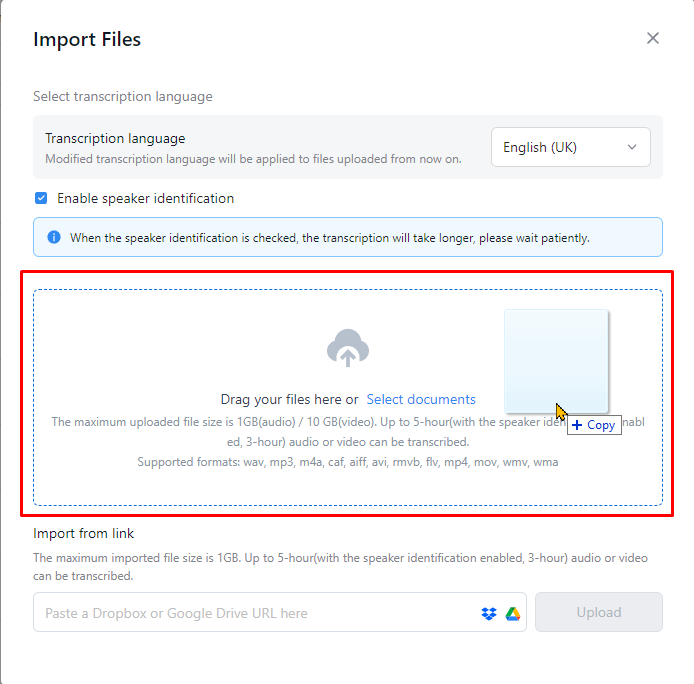
Step 5: Add Speakers and Proofread
- Click your transcript title under ‘Recent recordings’ to view the full text.

Alt text: Find your transcription file on your Notta dashboard
- Edit speaker names by clicking the speaker tag, renaming it, and choosing to change a single section of text or all of the text under the current tag.
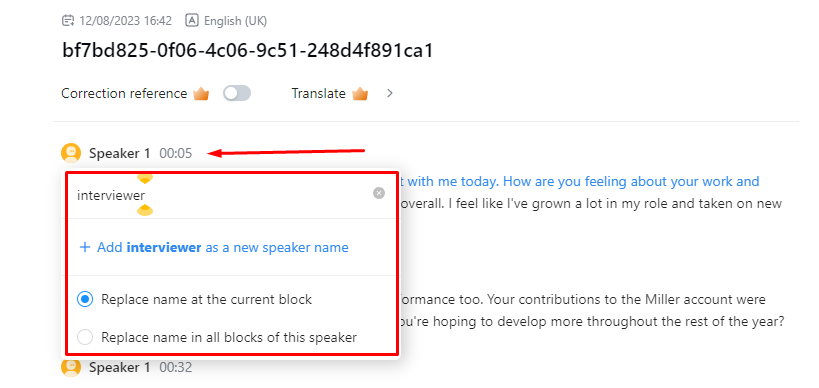
- Correct any mistranscribed words or spellings by editing the text just as you would with any text editor. The built-in audio player will skip to the text highlighted in blue for easy reference.
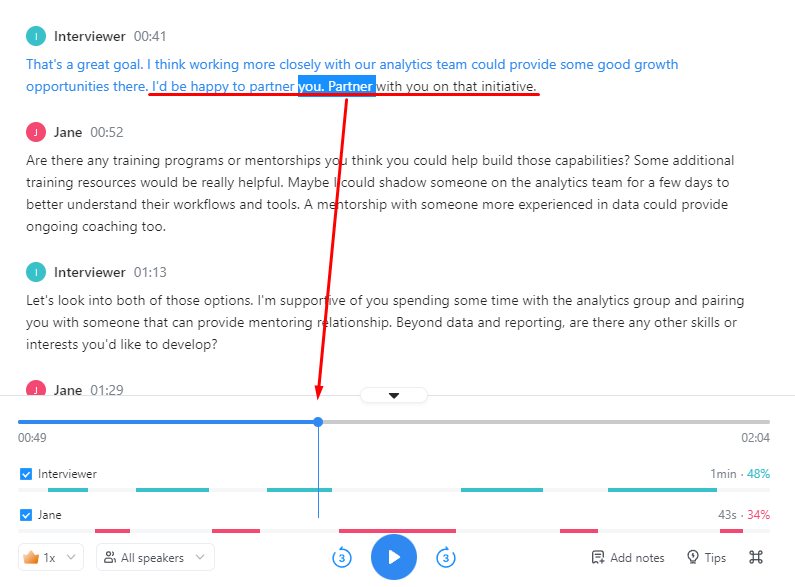
- Support your interview transcript by adding notes and images to sections of the text using the floating menu.
Alt text: Add supporting notes and images to the transcript
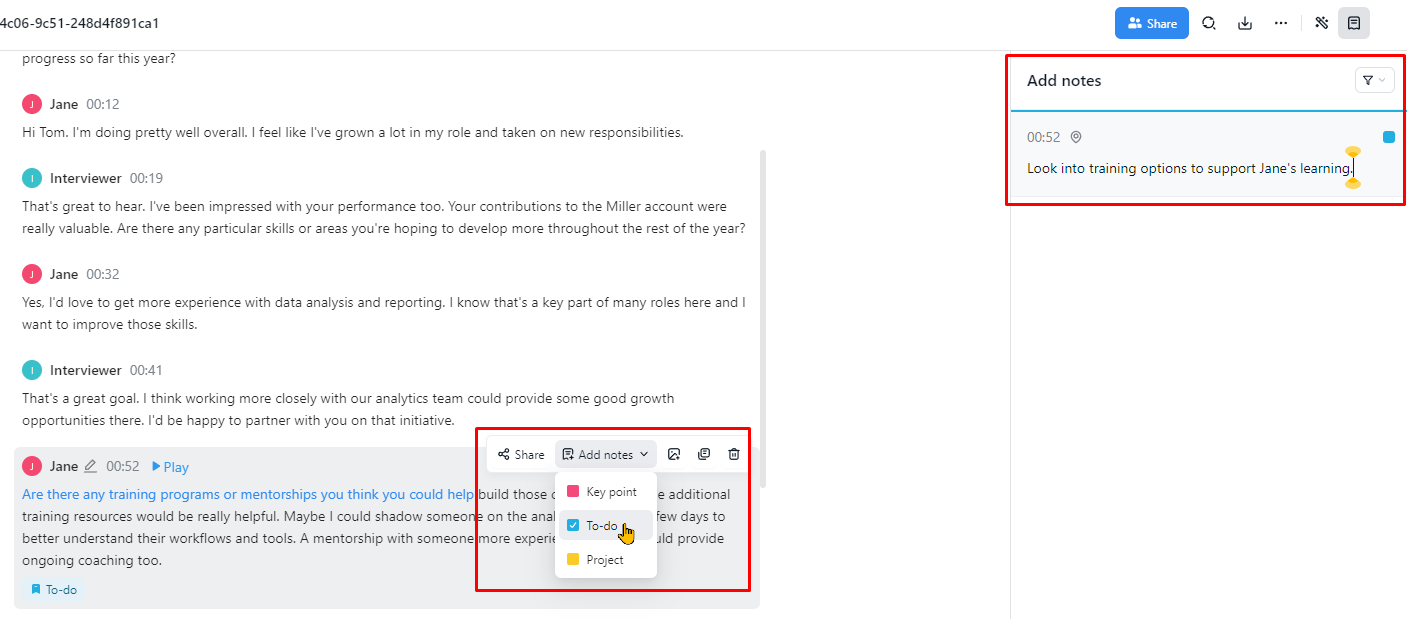
Step 6: Generate a Summary
You might want to summarize your interview in a project meeting or email. Notta AI Notes uses language learning to condense your interview transcript into two helpful formats.
- Summary: Condenses the most essential information from your transcript
- Action items: Provide the next steps you can assign to people or teams based on the conversation.
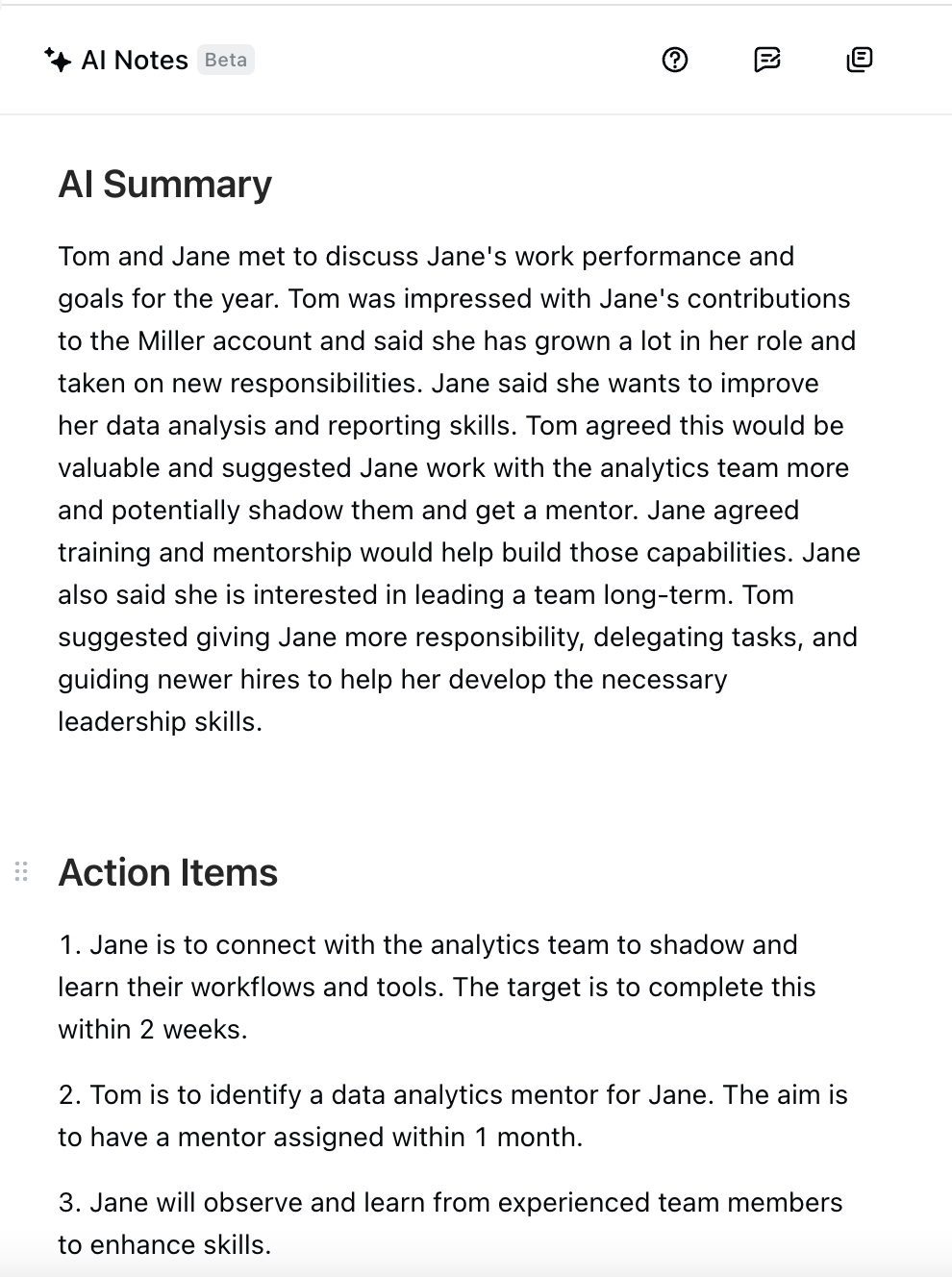
Alt text: The AI summary for this transcript
Step 7: Format and Export the Transcript
- Export your transcript by clicking the ‘Download’ icon. You can choose a variety of formats, but I’d recommend the SRT (SubRip Subtitle) file as this will display your timestamps clearly, with optional speaker tags.
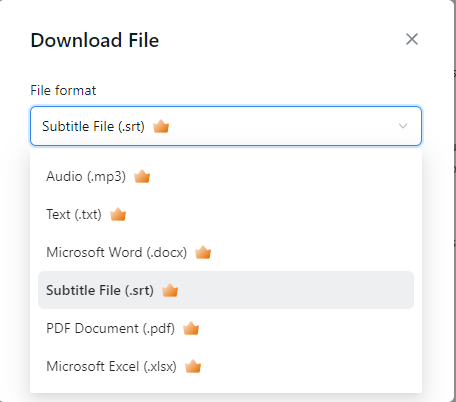
Alt text: Download the SRT file to your device
- Download other formats, including TXT, DOCX, PDF, MP3, and Excel.
- Click ‘Export’ to save it to your device.
Choosing Accurate Interview Transcription Software
When you transcribe interviews, you’ll probably want to spend less time transcribing and correcting errors and more time engaging with your interviewee. Thankfully, Notta works automatically with powerful features to help you create quick, accurate transcripts from interview audio and video.
Notta supports up to 104 transcription languages, which you won’t get with a human transcription service. Notta uses advanced speech recognition to achieve up to 98.86% accuracy with high-quality audio, so you spend less time correcting mis-transcribed text. It’s a tool for in-person, online, or phone interviews, as you can record from your microphone, upload an audio or video file, or even invite Notta Bot to transcribe an online meeting in real time.
Notta Key Features
- Over 2 million global users
- Support for 104 transcription languages
- Translate your transcript text into 41 other languages
- Notta Bot can auto-join scheduled meetings in Google Meet, Microsoft Teams, and Zoom
- Sync in real-time across web, desktop, and mobile apps
- Easily share your transcript text via a shareable link
- Major audio and video file formats supported
- Integrate with Notion and Salesforce
Example of Interview Transcripts
Job Interview Transcription for a Social Media Manager Position
00:00 – Interviewer (I): Good morning, thank you for coming in today. Can you start by introducing yourself?
00:05 – Interviewee (S): Good morning. Thank you for having me. My name is Sian, and I have been working in social media management for the past five years.
00:15 – I: Great, Sian. Can you tell us about a successful social media campaign you’ve led in the past?
00:22 – S: Certainly. In my previous role at SuperSocialz, I spearheaded a campaign for a new dating app. It involved a combination of organic content and paid advertising.
00:27- I: I see.
00:33 – S: We started with teaser posts two weeks before the launch, creating a sense of anticipation. On the launch day, we, um, mixed Instagram stories, live tweets, and Facebook updates to engage our audience in real-time. The campaign resulted in um, a 30% increase in product awareness and a 15% boost in sales within the first month.
Qualitative Research Interview Transcription For a Tech Company
00:00 – Interviewer: Hey there! Thanks for joining us today. Can you start by telling us a bit about yourself?
00:05 – Derek: Hey! No problem. I’m Derek, just your regular tech enthusiast. I love gadgets and am always on the lookout for cool stuff.
00:12 – Interviewer: Awesome! So, Derek, what kind of products or features do you generally get excited about?
00:20 – Derek: I’m a sucker for anything that makes life easier, you know? Smart home stuff is always interesting. Also, anything that helps me stay organized or saves time, too.
00:30 – Interviewer: Nice. Any specific features that you find super handy or anything you wish your current gadgets had?
00:36 – Derek: Yeah, definitely! I love voice control features. Being able to just tell my tech what to do is a game-changer. Also, battery life is crucial. I hate charging things every few hours.
Interview Transcription FAQs
What is the Easiest Way to Transcribe an Interview?
From my experience, the easiest, quickest way to transcribe an interview is using software- Notta. Notta uses advanced AI speech recognition technology to automatically convert your audio into text. Human transcription is slower than AI transcription software and can be pricey for longer audio files. Doing it yourself is highly time-consuming.
How to Transcribe an Interview
To transcribe an interview, follow these simple steps using a text editor like Notepad and a media player.
- Listen to the interview audio.
- Write a first draft of everything you hear, excluding timestamps and speakers.
- Listen through again and add speaker tags such as (Interviewer) or (interviewee) and timestamps in HH:MM:SS or MM:SS format.
- Correct any typos or missed information, then save your file to your device.
How Long Does it Take to Transcribe a 60-Minute Interview?
If you’re transcribing manually, it might take 3 hours or more to convert 60 minutes of audio into text. That’s due to starting and stopping the audio to type everything you hear, then adding speaker tags and timestamps.
With Notta, it’s much faster. Transcribe up to 5 hours of audio or video in around 10 minutes!
How Do I Format Interview Transcripts?
- Title your transcript clearly with interviewer and interviewee details, date, and time. This helps identify the interview among others.
- Label each speaker and keep it consistent. You can use the occupation (interviewer), name (Jake), or an abbreviation (D).
- Break down your text into paragraphs so it’s easy to digest. Every time the speaker changes, start a new paragraph.
- Use correct punctuation and spelling to avoid confusion.
- Include timestamps in HH:MM:SS or MM:SS format.
How can you Summarize an Interview?
There is a step-by-step process to summarize interviews manually.
Step 1: Refer to the interview recording or notes.
Step 2: Note down the key takeaways.
Step 3: Prepare summary format.
Step 4: Write in a formal tone.
Step 5: Give the context in the first paragraph.
Step 6: Add the following paragraphs.
Step 7: Add the key takeaways.
To automatically transcribe and summarize meetings quickly and accurately, consider using the Notta transcriber and summarizer.
Step 1: Sign in to Notta and navigate to your dashboard.
Step 2: Select ‘Import Files,’ then either drag your audio or video file into the designated box or paste a Google Drive or Dropbox URL into the ‘Import from link’ field.
Step 4: Make any necessary edits to your transcription or speaker names.
Step 5: Generate an AI summary by clicking on the ‘Magic wand’ icon at the top right of your transcript page.
Conclusion
While there are a few ways to transcribe interviews, we think automatic transcription is the best option for speed and efficiency. A benefit I haven’t already touched on is that with a multilingual tool, you could reach a global audience to conduct research in different countries for insights or to interview for international positions in your company.
You often won’t find that with human transcription—or if you do, it’s very expensive to find multilingual transcriptionists. Plus—even if you’re keeping your interviews local, you’ll save so much time using a tool that does it all for you (and accurately). Get started with Notta today.
How To Transcribe Interviews (with Examples)
